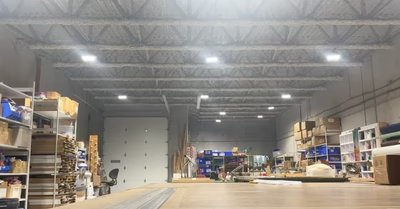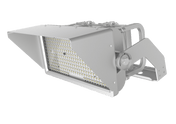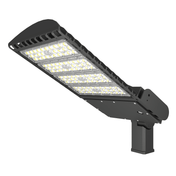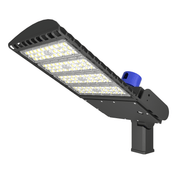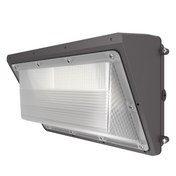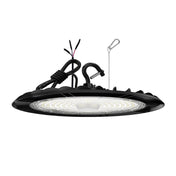Introduction
In the modern lighting industry, LED lights, with their numerous advantages such as energy saving, high efficiency, and long life, have become the preferred choice for various spaces. From bustling urban commercial centers to tranquil homes, LED lights are ubiquitous, transforming our living and working environments with their superior performance. Among the numerous LED lighting products, the distinction between high bay lights and low bay lights often creates confusion and uncertainty about how to choose. While both types of lighting fall under the category of industrial and commercial lighting, there are significant differences in their application scenarios, mounting heights, and lighting effects. Below, we will delve into the characteristics of LED high bay and low bay lights to help you find the lighting solution that best suits your space.
Ⅰ. High Bay and Low Bay Lighting: Basic Concepts
LED high bay lights are typically installed at a high point above the ground to illuminate large spaces. Generally, they are used when the installation height is above 6 meters, such as in factory workshops, gymnasiums, exhibition halls, large warehouses, and other locations where the ceiling is 6-15 meters or even higher. Their primary function is to provide sufficient and even lighting for large open spaces, ensuring that every corner is illuminated and meeting the visual needs of people engaging in various activities. The design characteristics of high bay lights dictate that they must possess high brightness, high luminous efficiency, and excellent heat dissipation to accommodate a wide illumination range and long-term use.
LED low bay lights are suitable for spaces with relatively low installation heights, typically 3-6 meters above the ground. They are commonly found in supermarkets, small warehouses, underground parking lots, restaurants, hotel lobbies, and other locations. Low-bay lighting is primarily used to provide appropriate illumination for relatively small spaces or those with low ceilings. In these spaces, while high brightness and a wide illumination range are not required, uniformity and comfort are highly valued. Low-bay lighting can create a warm and comfortable lighting environment.
II. High-bay Lights: The Brighteners of Large Spaces
(I) Appearance and Design Features
High-bay lighting offers a wide variety of designs to meet the needs of different scenarios. Among them, UFO-shaped high-bay lights are quite common. Their sleek, rounded appearance not only creates a pleasant visual effect but also reduces air resistance. This effectively minimizes the impact of the lighting on airflow in locations with high ventilation requirements, such as large industrial plants. UFO-shaped high-bay lights typically feature an integrated design, integrating the light source, heat sink, and lampshade into a compact structure and making installation easy.
Square-shaped high-bay lights, with their simple and elegant appearance, are suitable for a variety of minimalist spaces. These high-bay lights are widely used in modern warehouses, logistics centers, and other locations, blending in beautifully with their surroundings. In terms of heat dissipation, high-bay lights typically utilize large-area heat dissipation fins. These fins, like scales on a fish, are densely arranged, significantly increasing the heat dissipation area. This allows for rapid dissipation of heat generated during operation, ensuring stable operation. For example, some high-bay lights utilize a special aluminum alloy for its heat dissipation fins, which offers excellent thermal conductivity and quickly transfers heat to the air, effectively reducing the temperature of the lamp and extending its lifespan.
The shade material is also a key factor in high-bay light design. Common shade materials include PC (polycarbonate) and glass. PC shades are lightweight, resistant to breakage, and offer excellent impact resistance, effectively protecting the light source and electrical components within. PC also offers excellent light transmittance and weather resistance, resisting yellowing and aging even in harsh environments and long-term use. Glass shades, on the other hand, offer higher light transmittance, resulting in brighter, clearer light, providing superior lighting effects in large spaces. They are often used in venues requiring high light quality, such as exhibition halls and stadiums.
(II) Performance Parameter Highlights
High-bay lighting typically ranges from 50W to 600W. Lower-power 50W-100W high-bay fixtures are suitable for smaller spaces with relatively low lighting requirements, such as localized lighting in small warehouses. Larger spaces, such as factory workshops and logistics warehouses, often require high-power 150W-600W high-bay fixtures to ensure adequate illumination throughout the space. For example, a 5,000-square-meter logistics warehouse using 150W high-bay fixtures would require approximately 200-300 fixtures, based on lighting design specifications and actual lighting needs, to meet the lighting requirements for storage and handling of goods within the warehouse.
Luminous flux is a key indicator of a high-bay light's luminous capacity. Generally, high-bay fixtures offer a luminous flux of around 5,000-60,000 lumens. The higher the luminous flux, the brighter the light a fixture emits, and the wider the area it can illuminate. For example, a 150W high-bay fixture with a luminous flux of 18,000 lm can provide brighter and more even lighting than a 12,000 lm high-bay fixture of the same wattage, installed at the same height and in the same environment. This effectively reduces blind spots, improves visibility in the work area, and reduces visual fatigue and work errors caused by insufficient light.
Luminous efficiency is also a key performance parameter for high-bay fixtures. High-quality high-bay fixtures can achieve luminous efficiencies of 100 lm/W to 150 lm/W or higher. Higher luminous efficiency means the fixture can produce more light while consuming the same amount of electricity, resulting in better energy savings. For example, a factory previously used traditional metal halide high-bay lamps with a luminous efficiency of only around 80 lm/W. After replacing them with LED high-bay lamps with a luminous efficiency of 120 lm/W, the factory significantly reduced electricity consumption while maintaining the same lighting brightness. This significantly saves the factory significant annual electricity bills, while also reducing energy consumption and carbon emissions, in line with the concept of sustainable development.
(III) Typical Application Scenarios
In warehouses, goods are often stacked high and lined with shelves. High-bay lamps are required to provide sufficient and even lighting to facilitate storage, retrieval, and handling of goods. Installed on the warehouse ceiling, high-bay lamps can illuminate every corner, ensuring clear visibility of goods labels and preventing problems such as misplaced or misplaced goods due to insufficient light. For example, in an automated warehouse, high-bay lamps must not only illuminate the shelf areas but also provide good lighting conditions for the operation of automated equipment such as shuttles and stackers, ensuring accurate and reliable storage and retrieval of goods, thereby improving warehouse operational efficiency.
As venues for various sporting events and activities, gymnasiums place extremely high demands on lighting. High-bay lighting must offer high brightness, zero flicker, and a high color rendering index (CRI) to meet the needs of both athletes and spectators. During basketball games, the high brightness of high-bay lighting allows players to clearly see the position of the ball and their teammates, enabling them to make accurate decisions and decisions. The flicker-free nature of high-bay lighting prevents visual discomfort caused by flickering lights, ensuring a smooth game. The high CRI faithfully reproduces the colors of objects, making the colors of athletes' uniforms and the court more vivid and lifelike, providing a better viewing experience for spectators.
III. Low-bay Lighting: Warm Lighting for Low-Centered Spaces
(I) Unique Appearance and Construction
The design of low-bay lighting emphasizes integration with the environment and ease of installation. Recessed low-bay lighting can be perfectly embedded in the ceiling, making the fixture flush with the surface. This not only saves space but also creates a clean, uncluttered visual effect. This design is widely used in venues where aesthetics are paramount, such as hotel lobbies and high-end restaurants. Recessed low-bay lights require pre-cut holes in the ceiling. Once installed, the lampshade fits snugly into the ceiling, creating a sense of refinement and elegance.
Ceiling-mounted low-bay lights are mounted directly on the ceiling, offering quick and easy installation. Their lampshades come in a variety of shapes, with round and square being common. Round low-bay lights have a sleek, inviting design, adding a soft touch to any space and are often used in living rooms and bedrooms. Square low-bay lights offer clean lines and a more modern feel, making them suitable for minimalist commercial spaces, such as clothing stores and cafes. The lampshades of ceiling-mounted low-bay lights are typically made of highly translucent materials, such as acrylic. This material not only provides high light transmittance, ensuring even light distribution, but is also lightweight, resistant to breakage, and offers excellent safety features.
Compared to high-bay lights, low-bay lights are typically smaller and more compact. This is because low-bay lights are primarily used in low spaces and don't require the robust heat dissipation structures and large luminous surfaces of high-bay lights. Their smaller size makes them more flexible and convenient to install and use, adapting to a variety of complex spatial layouts. Furthermore, their exterior designs emphasize detail and decorative elements. Some even feature unique textures or patterns on the lampshades to enhance the lighting's artistic appeal and create a warmer, more comfortable atmosphere.
(II) Performance Parameter Interpretation
Low-bay lights typically draw between 10W and 150W, a lower power range compared to high-bay lights. This is because low-bay lights illuminate relatively small spaces and don't require excessively high power. In a small warehouse of 50 square meters, 30W to 50W low-bay lights, along with appropriate lighting layout and mounting height, can meet basic lighting needs for storage and simple operations. Lower power consumption not only reduces energy consumption but also reduces heat generation, extending lamp life.
In terms of luminous flux, low-bay lights generally range from 800lm to 15,000lm. Because low-bay lights are installed at a relatively low height, light loss during propagation is relatively minimal. Therefore, even with a low luminous flux, they can provide sufficient brightness within a limited space. For example, a 30W low-bay light with a luminous flux of 2,000lm can create a brightly illuminated area around itself in an underground parking lot installed at a height of 4 meters, ensuring drivers and pedestrians can clearly see their surroundings and ensuring safe driving.
Low-bay lights typically have a high color rendering index (CRI), typically above 80, with high-quality low-bay lights reaching over 90. A high CRI means that low-bay lights can more faithfully reproduce the colors of objects, ensuring that the colors perceived by the light are closer to the actual colors. In supermarket shelves, using low-bay lights with a high CRI can make the colors of goods appear more vibrant and attractive, stimulating consumers' purchasing desire. For example, fresh fruits and vegetables appear more vibrant and vibrant under lighting with a high color rendering index (CRI), attracting customers' attention and boosting sales.
(III) Common Applications
In supermarket shelving areas, low-bay lighting provides ample and even illumination for product display. Since shelves are typically around 2-3 meters high, low-bay lighting, installed above the shelves or on the ceiling, accurately projects light onto the products on the shelves, highlighting their features and details. The high CRI of low-bay lighting faithfully displays product colors, allowing consumers to more clearly understand the appearance and quality of the products, enhancing their shopping experience. Furthermore, the even light distribution of low-bay lighting avoids shadows and dark areas, ensuring that every product is fully illuminated and making it easier for consumers to select.
Underground parking lots are another important application for low-bay lighting. Ceiling heights in underground parking lots typically range from 3-5 meters, making low-bay lighting an ideal solution for the lighting needs of such low-ceiling spaces. The rational layout of low-bay lighting can provide uniform illumination in parking lots, ensuring drivers can clearly see the road, surrounding vehicles, and obstacles when entering and exiting the lot and searching for a parking space, thus improving driving safety. The energy-saving nature of low-bay lighting is also well-suited for underground parking lots, which require long-term lighting, effectively reducing operating costs. Some underground parking lots also utilize intelligently controlled low-bay lighting systems that automatically adjust light brightness based on traffic flow and time of day, further improving energy efficiency.
IV. Key Indicator Comparison: Basis for Decision Making
(I) Illuminance and Uniformity
Illuminance refers to the amount of visible light received per unit area, measured in lux (lx). It directly reflects the brightness of a space. In industrial plants, illuminance of 200-500 lx is generally required to ensure workers can clearly see products and operational processes on the production line. In warehouses, however, where storage and handling are the primary areas, the required illumination is relatively low; 100-200 lx is generally sufficient.
Uniformity measures the uniformity of light distribution within an illuminated area. Ideally, uniformity should be close to 1, meaning that illumination is essentially the same at all locations. Poor uniformity can lead to noticeable differences in brightness within a space, easily causing visual fatigue and impacting work efficiency and safety. In supermarket shelves, poor uniformity in low-bay lighting can cast shadows on some products, hindering customer selection. In stadiums, poor uniformity in high-bay lighting can negatively impact both athletes' performance and the spectator's viewing experience.
Due to their high mounting height, high-bay lighting typically requires high power and luminous flux to achieve sufficient illumination at ground level. In large stadiums, where installation heights may exceed 10 meters, high-bay lighting may require 300W to 600W power and a luminous flux of 30,000 to 60,000 lumens (lm) to ensure the illumination within the venue meets competition requirements. However, as the mounting height increases, light distribution gradually diverges, resulting in reduced uniformity. To improve uniformity, high-bay lighting often employs specialized optical designs, such as batwing lighting, to achieve more even light distribution across the work area.
Low-bay lighting, with its lower mounting height, offers a shorter light travel distance and minimizes light loss. It can achieve high illumination within a smaller space at lower power and luminous flux. In a restaurant, 30W-50W low-bay lights with a luminous flux of approximately 2000lm-5000lm can provide comfortable lighting for the dining area, with an illuminance of 150-300lx. Furthermore, the shade design and light distribution of low-bay lights allow for better control of light direction and distribution, resulting in relatively high uniformity and creating a comfortable and warm lighting environment.
(II) Energy Efficiency
High-bay lights typically have a wide power range, ranging from 50W to 600W, to meet the lighting needs of large spaces. In some large factory workshops, due to their large area and high height, high-power high-bay lights are required to provide sufficient brightness. However, with the continuous development of LED technology, the energy efficiency of high-bay lights has been significantly improved. Modern LED high-bay lighting can achieve luminous efficacy of 100-150 lm/W or more, reducing energy consumption by 40%-60% compared to traditional high-bay lighting such as metal halide and high-pressure sodium lamps. For example, a factory replaced its 250W metal halide high-bay lighting with 150W LED high-bay lighting, saving significant annual electricity costs while maintaining the same lighting brightness.
Low-bay lighting has a relatively low power consumption, typically between 10W and 150W, which reduces energy consumption. Since low-bay lighting is primarily used in smaller spaces, it doesn't require excessive power to provide illumination. Low-bay lighting also incorporates advanced energy-saving technologies, such as efficient drivers and optimized optical designs, to further enhance energy efficiency. In underground parking lots, using low-power low-bay lighting not only meets lighting needs but also reduces long-term operating costs.
To achieve even more energy-efficient lighting, both high-bay and low-bay lighting can utilize intelligent control systems. Light-control sensors detect ambient light intensity and automatically adjust the brightness of the lamps, dimming them during bright daylight hours and increasing them at night when light levels are low, effectively reducing energy consumption. Timer control and motion sensing can also be used to automatically turn the lamps on and off based on actual demand, avoiding unnecessary energy waste.
(III) Installation and Maintenance Difficulty
High-bay lamps are installed at high heights, typically exceeding 6 meters, which poses certain installation and maintenance challenges. During installation, specialized aerial work equipment, such as lifts and cranes, is required to ensure the safety of installers. Furthermore, due to their large size and weight, installation requires the collaboration of multiple personnel, increasing the difficulty and time required. For example, installing high-bay lamps in a large warehouse may require scaffolding or the use of a lift. Installers must precisely mount the lamps in the designated ceiling locations, perform wiring, and perform commissioning, a complex process.
In terms of maintenance, high-bay lamps require relatively low maintenance frequency, thanks to their long lifespan. Modern LED high-bay lamps are typically designed to last over 50,000 hours. However, if maintenance is required, the high installation height makes it costly and difficult. If a high-bay light malfunctions, professionals carrying tools and equipment must perform overhead work to inspect and replace the fixture. To reduce maintenance complexity, some high-bay lights adopt a modular design, separating components such as the light source and driver into separate modules. This facilitates ground-level repair and replacement, reducing the need for overhead work.
Low-bay lights are installed at a lower height, typically between 3 and 6 meters, making them relatively simple to install. While recessed low-bay lights require pre-cut holes in the ceiling, the installation process is relatively straightforward and can be completed by ordinary installers using simple tools such as a ladder. Ceiling-mounted low-bay lights are even simpler to install; simply attach the fixture to the ceiling. When installing low-bay lights in a small supermarket, installers can easily perform installation work from a ladder, eliminating the need for complex equipment.
Low-bay lights are also relatively easy to maintain. Due to their low installation height, maintenance personnel can easily inspect, clean, and replace the fixtures. Their relatively simple structure and limited number of parts also reduce maintenance challenges. If a low-bay light malfunctions, maintenance personnel can quickly identify the problem and perform appropriate repairs or replacements, effectively minimizing the impact of lighting failures on normal operations.
V. Space Adaptation Principle: The Secret to Accurate Selection
(I) Industrial Spaces
Industrial spaces such as factory workshops and logistics warehouses are typically characterized by large, open spaces, densely stacked goods, and frequent human activity. In these spaces, the primary purpose of lighting is to meet production and operational needs, ensuring workers have a clear view of their work areas and goods, thereby improving efficiency and safety.
For large factory workshops and logistics warehouses with heights exceeding 6 meters, high-bay lighting is an ideal choice. The high brightness and luminous flux of high-bay lighting can illuminate large areas, ensuring sufficient illumination even when goods are stacked high. In the assembly halls of automotive manufacturing plants, which can reach heights exceeding 10 meters, high-powered high-bay lighting, such as 300W-600W LED high-bay lights, can provide uniform, bright illumination throughout the entire workshop, enabling workers to accurately perform component installation and commissioning.
Low-bay lighting can be advantageous in areas with relatively low ceilings, such as small industrial plants or warehouses under 6 meters. Low-bay lighting provides a more concentrated light distribution, providing more adequate illumination for specific work areas. In processing areas of small machining plants, low-bay lighting can focus on illuminating machine tool operating areas, meeting workers' lighting needs for delicate operations while avoiding unnecessary energy waste.
(II) Commercial Spaces
The lighting needs of commercial spaces such as shopping malls, supermarkets, and hotel lobbies are increasingly diverse. They must not only meet basic lighting functions but also create a comfortable and attractive shopping and consumption environment to enhance the customer experience and boost sales.
In shopping malls and supermarkets, shelf areas require adequate and even lighting to highlight the details and colors of products and attract customers' attention. The mounting height and light distribution characteristics of low-bay lighting make them ideal for shelf lighting. In supermarket food sections, low-bay lighting can enhance the colors of food and stimulate customers' purchasing desire. For open areas like shopping mall atriums and corridors, high-bay or low-bay lighting can be chosen depending on the height and area of the space. If the atrium is taller, exceeding 6 meters, high-bay lighting provides sufficient brightness and coverage. If the atrium is between 3 and 6 meters, low-bay lighting can create a warm and comfortable atmosphere.
As the hotel's main entrance, the lighting design of the hotel lobby should reflect the hotel's style and quality, creating a luxurious and comfortable atmosphere. Low-bay lighting can add an artistic and decorative touch to the lobby through various shapes and lighting effects. Some hotel lobbies use unique ceiling-mounted low-bay lighting with warm tones to create a warm and elegant atmosphere, making customers feel comfortable and happy the moment they enter the hotel.
(III) Public Spaces
The lighting design of public spaces such as subway stations and libraries needs to meet the needs of different users, while also considering factors such as energy conservation, environmental protection, and maintenance costs.
As a place with high traffic volume, the primary lighting priority of subway stations is to ensure passenger safety and comfort. Station concourses and platforms typically require high and uniform illumination to facilitate passenger identification of signage, navigation, and waiting for trains. Since subway station heights typically range from 5 to 8 meters, both high-bay and low-bay lighting are used. Some newly built subway stations utilize high-brightness, energy-saving LED high-bay lighting. Through rational lighting layout and light distribution design, uniform illumination throughout the concourse and platforms is achieved. To minimize the visual impact of the lighting, the installation position and angle of the lighting fixtures must also be carefully designed to avoid glare.
Libraries are places for reading and studying, requiring high levels of lighting comfort and stability. Low-bay lighting, with its low glare and high color rendering index, is a preferred choice for library lighting. In library bookshelves, low-bay lighting provides clear illumination of books, making it easier for readers to find them. In reading areas, adjustable low-bay lighting can meet diverse reading needs, creating a quiet and comfortable reading atmosphere. At the same time, in order to protect readers' eyesight, library lighting should also avoid flickering and excessively high color temperature. Generally, lamps with a color temperature between 4000K and 5000K should be selected.
VI. Case Analysis: Decisions Made in Real-World Scenarios
(I) A Large Warehouse Renovation Case Study
A large logistics warehouse with a floor area of 20,000 square meters and an interior height of 8 meters was used. Before the renovation, the warehouse used traditional high-pressure sodium lamps, which presented numerous issues. Insufficient lighting brightness resulted in dim lighting in some areas of the warehouse, making it difficult for workers to locate and move goods. They frequently required the use of additional lighting tools such as flashlights, which not only reduced work efficiency but also increased the risk of damage to goods and injury. High-pressure sodium lamps consume a lot of energy, and over time, electricity costs have become a significant burden on warehouse operating costs. Maintenance costs were also high. Due to the short lifespan of high-pressure sodium lamps, frequent bulb and ballast replacement was required, which was not only labor-intensive and labor-intensive, but also resulted in insufficient lighting during the replacement period, impacting normal operations.
After evaluation by a professional lighting design team, the decision was made to retrofit the warehouse lighting system with LED high-bay lamps. The primary reason for choosing high-bay lamps was their ability to meet the lighting needs of the warehouse's large spaces. High-bay lighting boasts high brightness and high luminous flux, providing ample light throughout the warehouse, ensuring clear illumination in every corner. LED high-bay lighting is also highly energy-efficient, reducing energy consumption by over 50% compared to traditional high-pressure sodium lamps, significantly reducing the warehouse's electricity bill. LED high-bay lighting also boasts a long lifespan of over 50,000 hours, reducing the frequency of lamp replacements and lowering maintenance costs.
After the renovation, the warehouse's lighting has been significantly improved. Previously dimly lit areas have become bright and clear, with clear product labels visible, allowing staff to quickly and accurately locate required items, significantly improving work efficiency. According to actual statistics, cargo handling efficiency has increased by over 30%, effectively reducing storage and turnover time. Energy savings are also significant. The installation of an intelligent control system automatically adjusts lighting brightness based on the warehouse's actual lighting needs, further reducing energy consumption. Compared to pre-renovation levels, the warehouse's annual electricity bill has been reduced by approximately 60,000 yuan, a significant energy saving achievement. At the same time, the long lifespan and low failure rate of LED high-bay lights save approximately 20,000 yuan in annual lamp maintenance costs, effectively ensuring the long-term stable operation of the warehouse.
(II) Lighting Optimization in a Community Underground Parking Lot
A community underground parking lot has a total area of 5,000 square meters and a ceiling height of 4 meters. The original lighting system used traditional fluorescent lamps, which gradually developed problems over time. Lighting uniformity was poor, with distinct bright and dark areas within the parking lot. Some parking spaces and aisles were underlit, causing inconvenience for drivers parking and moving around, and increasing safety hazards. Fluorescent lamps also have a low color rendering index, failing to accurately reproduce colors, making the parking lot appear dim and depressing, impacting the driver experience. Furthermore, fluorescent lamps consume a lot of energy, and the long-term electricity costs are significant.
To improve the lighting conditions in the underground parking lot, after comprehensive consideration, the decision was made to use LED low-bay lights for lighting optimization. The mounting height and light distribution characteristics of low-bay lamps are ideally suited to low-ceiling spaces like underground parking lots. Their high color rendering index (CRI) accurately reproduces the colors of objects, creating a brighter and more comfortable parking environment. Low-bay lighting also outperforms traditional fluorescent lamps in energy efficiency, reducing parking lot operating costs.
After optimization, the lighting quality of the underground parking lot has been significantly improved. Light distribution is more even, eliminating bright and dark areas, and improving parking and pedestrian safety. The high CRI of low-bay lighting creates a warmer and more comfortable parking environment, enhancing the user experience. By utilizing an intelligent sensor control system, the lights automatically illuminate and adjust to the appropriate brightness when a vehicle or pedestrian enters the parking lot. When no one or a vehicle is in the area, the lights automatically dim or turn off, further reducing energy consumption. According to statistics, the optimized underground parking lot lighting system has reduced energy consumption by approximately 40%, saving approximately 15,000 yuan in electricity bills annually. This also reduces the frequency of lamp replacement and reduces maintenance costs.
VII. Purchasing Recommendations: Making an Informed Decision
(I) Brand and Quality Considerations
Brand is a key consideration when choosing LED high-bay and low-bay lights. Well-known brands typically possess advanced production technology and strict quality control systems, ensuring product quality and performance. Brands like OSRAM, Philips, and NVC Lighting have extensive experience and a strong reputation in the LED lighting field, and their products excel in terms of luminous efficacy, stability, and lifespan. For example, OSRAM's LED high-bay lights utilize high-quality LED chips and advanced heat dissipation technology, resulting in luminous efficacy exceeding 140 lm/W and a lifespan exceeding 50,000 hours, providing users with a reliable lighting solution.
There are many ways to assess the quality of a lamp. A visual inspection can provide a preliminary assessment of its quality. A high-quality lamp housing is typically made of durable, heat-dissipating materials, such as aluminum alloy, with a smooth surface and no obvious defects. The lampshade should be transparent and resistant to yellowing and aging. Check that the lamp beads are neatly arranged and free of missing or damaged components. You can also check for product certifications, such as CE and RoHS, which indicate compliance with relevant international standards and guarantee quality. Using professional equipment to measure various lamp performance parameters, such as luminous flux, color temperature, and color rendering index, is also an effective way to judge lamp quality.
(II) Budget Planning Tips
Budget planning is an essential step when purchasing lamps. First, determine the number and wattage of lamps based on the size of the space to estimate the approximate purchase cost. For a 1,000-square-meter warehouse, if you choose 150W high-bay lights, assuming each lamp illuminates 30-50 square meters, you'll need approximately 20-30 lamps. The purchase cost alone will require a considerable amount of money.
Lighting requirements are also a significant factor influencing your budget. If you have high requirements for light uniformity and color rendering index, you may need to choose higher-quality, more expensive lamps. In exhibition halls, to accurately reproduce the colors of exhibits, lamps with a high color rendering index (Ra ≥ 90) are required, and these lamps are generally more expensive than standard lamps. Another consideration is the energy-saving performance of the lighting fixtures. While the initial investment in energy-saving lamps may be higher, long-term use can significantly reduce electricity costs, ultimately reducing costs in the long run.
(III) Key Points to Consider for After-Sales Service
After-sales service is crucial to the performance of lighting fixtures. When purchasing lighting fixtures, it's important to understand the warranty period offered by the vendor. Generally speaking, high-quality LED lamps offer warranties between 2 and 5 years. Some well-known brands even offer warranties up to 5 years, demonstrating confidence in their product quality. Vendors should provide timely repair and replacement services. When a lamp malfunctions, they should respond quickly and arrange for professional repair or replacement, minimizing the impact of lighting failures on normal operations. Also consider whether vendors offer value-added services such as installation guidance and user training. These services can help users better use and maintain the lamps.
VIII. Summary and Outlook
LED high-bay and low-bay lighting play an important role in their respective applications. High bay lighting, with its high brightness, high luminous flux, and excellent heat dissipation, is the ideal choice for illuminating large spaces. In places like industrial plants, large warehouses, and stadiums, it provides ample, even light, ensuring smooth operation of various activities. Low bay lighting, with its compact size, high color rendering index, and excellent light uniformity, creates a warm and comfortable lighting environment in low-ceilinged spaces. It is widely used in supermarkets, underground parking lots, and restaurants, meeting the lighting needs of various scenarios.
When choosing between LED high bay and low bay lighting, multiple factors need to be considered. Space height and area are primary considerations. Based on the actual height and area of the space, select a lamp with the appropriate wattage and luminous flux to ensure a balance between lighting performance and energy savings. Lighting requirements are also crucial. Different locations have different requirements for contrast, uniformity, and color rendering index, so the appropriate lamp should be selected based on specific needs. Installation and maintenance are also important factors. High bay lighting is relatively complex to install and maintain, requiring specialized equipment and personnel, while low bay lighting is relatively simple to install and maintain.
With the continuous advancement of technology, LED lighting technology is also developing continuously. In the future, LED high-bay and low-bay lighting are expected to achieve breakthroughs in the following areas. Luminous efficiency and energy-saving performance will be further improved. By optimizing chip technology and optical design, lamps can produce brighter light while consuming less power, saving users more energy costs. Intelligent control will become a mainstream trend. Lamps can be connected to intelligent systems to achieve remote control, automatic dimming, and human presence sensing. They will automatically adjust lighting according to environmental changes and user needs, providing a more convenient and comfortable lighting experience. Lamp lifespan and reliability will also continue to improve, reducing maintenance costs and replacement frequency. We believe that in the future, LED high-bay and low-bay lamps will provide even better performance and bring higher-quality and efficient lighting services to our living and working spaces.

